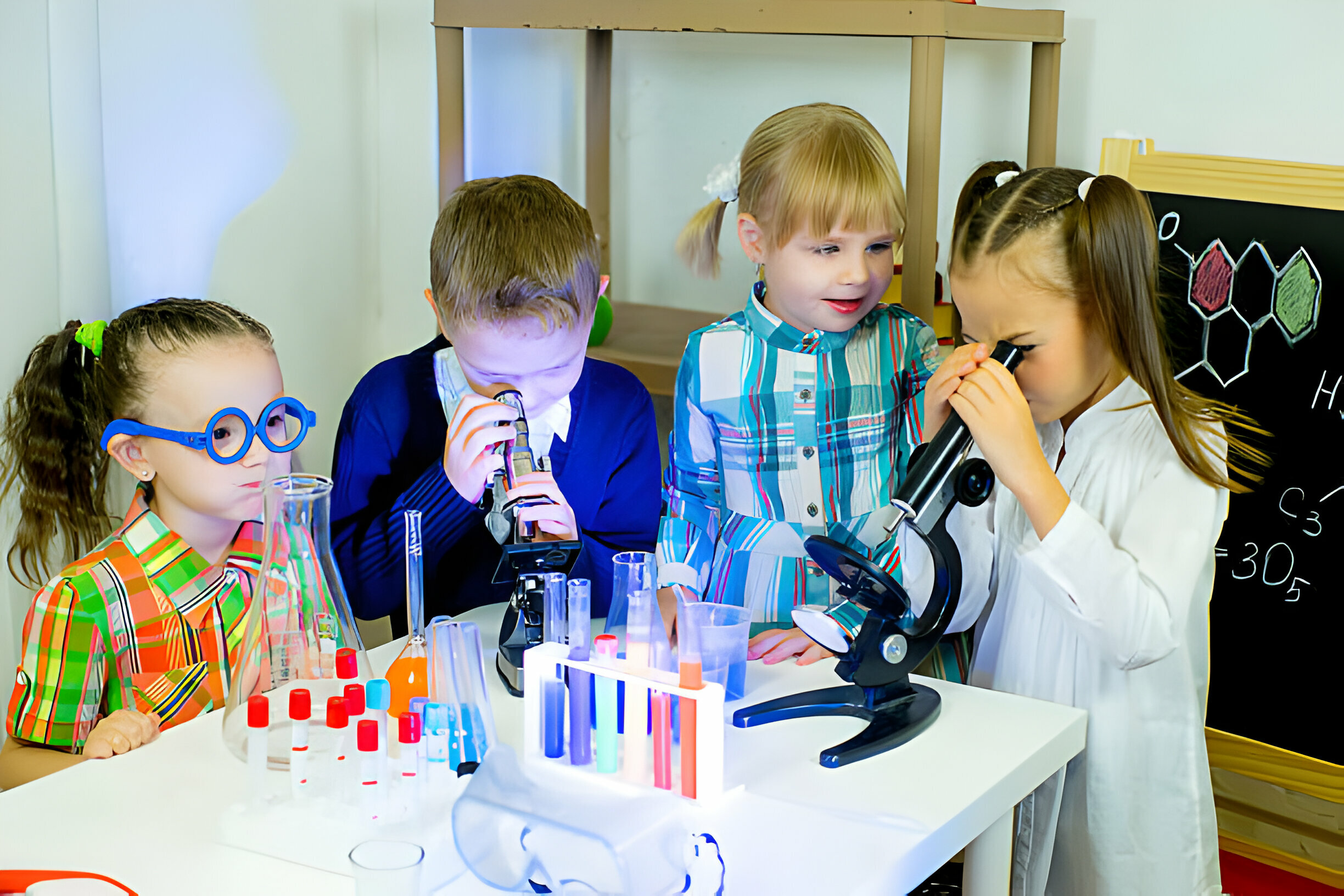Curiosity killed the cat, but it’ll only make you smarter with these investigative 6th-grade science projects! Dive into the magic of microorganisms, explore photosynthesis’s power, and uncover secrets of sound waves. Investigate genetics, density, food preservation chemistry, climate change impacts, astronomy wonders, and simple machine engineering solutions. Let’s embark on a scientific journey that will ignite your inquiring mind and spark a passion for discovery!
The Magic of Microorganisms
Let’s explore the fascinating world of microorganisms and their magical properties! Microbial ecosystems are like tiny universes, teeming with diverse life forms. Within these microscopic worlds, you’ll encounter pathogenic bacteria that can cause diseases, reminding us of both the wonders and dangers of these unseen creatures. Don’t forget about the incredible fungal diversity present in soil, water, and even our bodies, showcasing nature’s artistic flair in creating unique organisms. Witness the marvels of microbial metabolism as these minuscule beings break down substances for energy in ways that seem almost mystical. And be wary of protozoan parasites lurking in unexpected places, highlighting the intricate relationships within the microbial realm that impact our daily lives without us even realizing it.
Exploring the Power of Photosynthesis
You can observe how plants convert sunlight into energy through photosynthesis. This process is vital for producing green energy and sustaining life on Earth. As plants absorb sunlight, they convert it into chemical energy, enabling them to grow and thrive. Not only does photosynthesis promote plant growth, but it also plays a crucial role in oxygen production and carbon dioxide absorption. Through this remarkable mechanism, plants release oxygen as a byproduct while absorbing carbon dioxide from the atmosphere, helping to maintain the delicate balance of gases essential for life. Understanding photosynthesis sheds light on the interconnectedness of living organisms and the environment, showcasing the incredible power of nature’s processes in sustaining life.
Uncovering the Secrets of Sound Waves
Explore how sound waves travel through different mediums, impacting our perception of the world around us. Sound propagation involves the transmission of these waves through air, water, and solids. Frequency analysis allows us to understand pitch variations in sounds we hear daily. Wave interference occurs when two or more sound waves interact, creating patterns of reinforcement or cancellation. Echo detection helps us locate objects by analyzing reflected sound waves. Acoustic resonance describes the phenomenon where objects vibrate at their natural frequency when exposed to external sound waves, amplifying the sound produced. By studying these concepts, you can unravel the mysteries behind how sounds move and behave in diverse environments, shaping your auditory experiences profoundly.
Investigating the World of Genetics
Dive into the fascinating realm of genetics by examining how traits are passed down from parents to offspring through DNA inheritance. Genetic variation plays a crucial role in shaping individual characteristics, highlighting the uniqueness of each living being. Explore the wonders of hereditary traits and unravel the mysteries behind Punnett squares, essential tools for predicting offspring traits based on parental genes. Witness the power of gene expression as it dictates how genetic information is utilized within an organism’s cells.
- DNA sequencing
- Genetic variation
- Hereditary traits
- Punnett squares
Delving Into Density and Buoyancy
Delve into the concepts of density and buoyancy by understanding how objects float or sink based on their relative weights in a fluid medium. Through buoyancy experiments, you can observe firsthand how different objects behave when placed in water. Conduct density investigations to explore why some items rise to the surface while others sink below. Analyze floating objects to determine what factors contribute to their ability to stay afloat. Dive into mass and volume exploration to grasp how these properties influence an object’s behavior in water. Lastly, engage in water displacement research to see how an object’s volume affects the amount of water it displaces, ultimately affecting its buoyancy. Explore these hands-on activities to deepen your understanding of density and buoyancy principles.
Analyzing the Effects of Acid Rain
Let’s analyze how acid rain impacts the environment and its effects on ecosystems. Acid rain can have significant environmental implications, especially when considering pH levels analysis and water quality assessment. In investigating this topic further, it is crucial to delve into chemical reactions to understand how acid rain forms and its detrimental effects on plant health. When conducting experiments or projects related to acid rain, consider the following:
- pH levels analysis: Measure the acidity of rainwater samples.
- Environmental implications: Explore how acid rain influences soil quality and aquatic life.
- Chemical reactions investigation: Study the reactions between pollutants and precipitation.
- Plant health examination: Assess the impact of acid rain on vegetation growth.
Understanding these aspects is essential for comprehending the broader consequences of acid rain on our ecosystems.
Solving the Mystery of Static Electricity
So, you’ve explored the effects of acid rain, but have you ever delved into the world of electric charges and static interactions? When it comes to solving the mystery of static electricity, one key aspect to consider is how different materials behave. Some materials are conductive, allowing electric charges to flow easily, while others create frictional forces that lead to electrical discharge.
To better understand this concept, let’s take a look at a comparison between conductive and non-conductive materials in the table below:
| Conductive Materials | Non-Conductive Materials |
|---|---|
| Metals | Rubber |
| Copper | Plastic |
| Water | Wood |
| Aluminum | Glass |
Understanding the Science of Solar Energy
Exploring the science of solar energy can help us comprehend how sunlight is converted into usable electricity through photovoltaic cells. Solar panels play a crucial role in harnessing renewable energy from the sun, contributing to a sustainable future. Understanding sunlight absorption is key in maximizing the efficiency of solar technology, ensuring optimal energy production. By delving into the intricacies of solar energy, you can grasp the significance of energy efficiency and its impact on environmental conservation.
- Solar panels
- Renewable energy
- Sunlight absorption
- Solar technology
Examining the Wonders of Water Filtration
So, you’ve delved into the realm of solar energy, and now it’s time to explore the fascinating world of water filtration. When it comes to understanding water quality, purification techniques are essential. Dive into your investigative 6th-grade science project by exploring various filtration methods and materials. Take a look at the table below for some inspiration on potential filtration experiments you can conduct:
| Filtration Methods | Water Quality | Purification Techniques | Filtration Materials |
|---|---|---|---|
| Sand Filtration | pH Levels | Boiling | Activated Carbon |
| Reverse Osmosis | Turbidity | Distillation | Filter Paper |
| UV Sterilization | Heavy Metal Content | Chlorination |
Get ready to uncover the wonders of water filtration in your next science fair project!
Probing the Phenomenon of Plant Growth
Discover how plants grow and thrive by observing their growth patterns in different environments. When conducting your experiment, pay close attention to the following factors:
- Soil Composition: Influences growth rates significantly.
- Light Intensity: Critical for proper plant development.
- Water Availability: Affects root systems and overall health.
- Temperature Fluctuations: Impact leaf growth and metabolism.
Understanding these elements can provide insights into how plants adapt and respond to their surroundings. By manipulating variables like nutrient levels, you can also study flowering patterns. Remember, each factor plays a vital role in the holistic understanding of plant growth. Happy experimenting!
Testing the Laws of Motion
Now that you’ve explored the wonders of plant growth, it’s time to dive into the exciting world of testing the laws of motion. Get ready for force experiments, motion investigations, velocity studies, momentum observations, and friction tests. You’ll be setting up various scenarios to understand how forces impact an object’s motion. By conducting experiments and making observations, you’ll uncover the principles behind why objects move the way they do. Measure velocities and analyze momentum changes to see how these factors affect movement patterns. Don’t forget about friction; it plays a crucial role in how objects interact with surfaces. So grab your materials and get ready to unravel the mysteries of motion through hands-on experiments!
Observing the Behavior of Light
You’ll find that observing the behavior of light can lead to fascinating discoveries about how it interacts with different materials and surfaces. Light reflection and refraction are key aspects to consider when exploring the properties of light. Understanding light absorption and transmission can provide insights into its behavior in various mediums. Through engaging in light experiments, you can uncover intriguing results that showcase the versatility of this natural phenomenon. Experimenting with different light sources can help you grasp concepts like shadows and how they form based on the placement of objects relative to a light source. Delve into the captivating world of light through hands-on investigations for an enlightening scientific journey.
- Light reflection, refraction
- Properties of light
- Light absorption, transmission
- Light experiments, results
Discovering the Chemistry of Food Preservation
Exploring the chemistry of food preservation can reveal how different techniques and additives can help extend the shelf life of perishable items. Chemical reactions play a vital role in food preservation methods by inhibiting microbial growth or slowing down enzymatic reactions that lead to food spoilage. Understanding food chemistry is key to implementing effective food preservation techniques. From canning and pickling to freezing and drying, various preservation methods rely on specific chemical reactions to maintain the quality and safety of food products. By learning about these processes, you can enhance your knowledge of food spoilage prevention and ultimately make informed decisions when it comes to preserving perishable items for longer periods.
Investigating the Impact of Climate Change
You can observe how climate change is affecting ecosystems and weather patterns around the world. As temperatures rise and ice continues to melt, the following impacts are becoming more prevalent:
- Changing weather patterns leading to more frequent extreme events
- Impact on ecosystems causing biodiversity loss
- Mitigation strategies such as transitioning to renewable energy sources
It’s crucial for everyone to understand the urgency of addressing climate change. Global efforts and climate action initiatives aim to combat this issue collectively. By educating yourself and others about these changes, you can contribute positively towards protecting our planet for future generations. Take part in sustainable practices and support initiatives that promote a greener, cleaner Earth.
Exploring the Universe Through Astronomy
Intrigued by the mysteries of the cosmos? Let’s delve into the wonders of astronomy! From stellar observations to galactic exploration, there’s a universe of celestial phenomena awaiting your investigation. Unveil astronomical discoveries and embark on an exciting journey through space exploration.
Check out this table below for some inspiration on potential 6th-grade science projects in astronomy:
| Project Title | Description | Materials Needed |
|---|---|---|
| Investigating Star Brightness | Measure and compare star brightness using a telescope | Telescope, light meter |
| Creating a Solar System Model | Construct a scale model showcasing the planets | Styrofoam balls, paint |
| Tracking Lunar Phases | Record and analyze moon phases over time | Moon phase chart, notebook |
Ready to launch your investigative journey into the vastness of our universe? Let’s reach for the stars together!
Engineering Solutions With Simple Machines
Let’s delve into how engineers solve problems using simple machines! Engineers rely on various simple machines to make tasks easier and more efficient. Lever designs, pulley systems, inclined planes, wheel and axle setups, and screw mechanisms all play crucial roles in engineering solutions.
- Lever designs help amplify force or lift heavy loads with less effort.
- Pulley systems enable lifting heavy objects by distributing the weight across multiple ropes and pulleys.
- Inclined planes reduce the amount of force needed to move objects vertically by increasing the distance over which the force is applied.
- Wheel and axle mechanisms allow for efficient movement of objects by rotating around a common axis.
Understanding these simple machines empowers engineers to innovate and create solutions for complex challenges efficiently.



